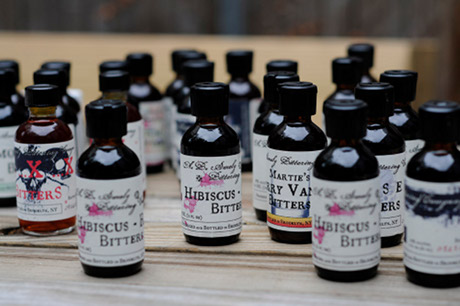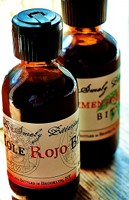 In a borough brimming with culinary renegades, it’s hard to imagine there’s anything Brooklyn food geeks haven’t mastered. We have our brewers and bakers; our chicken farmers and bee keepers. We rarely have to look beyond our corner market to score local, artisanal anything. So when Louis Smeby, the mastermind behind A.B. Smeby Bittering Co., revealed that he makes hand-crafted bitters in South Slope, we weren’t surprised. Impressed, but not surprised. The real surprise was that he’s the first bitters maker of his generation this side of the East River.
In a borough brimming with culinary renegades, it’s hard to imagine there’s anything Brooklyn food geeks haven’t mastered. We have our brewers and bakers; our chicken farmers and bee keepers. We rarely have to look beyond our corner market to score local, artisanal anything. So when Louis Smeby, the mastermind behind A.B. Smeby Bittering Co., revealed that he makes hand-crafted bitters in South Slope, we weren’t surprised. Impressed, but not surprised. The real surprise was that he’s the first bitters maker of his generation this side of the East River.
If you don’t know what bitters are, take heart. Most of us don’t, but we know how we like our Old Fashioned or Manhattan: Whiskey or Brandy, Vermouth or an orange rind, and a dash of something from a bottle. That “something from a bottle” is bitters: alcohol-based, potent tinctures often flavored with herbs and spices.
“Bitters derived in Europe a few hundred years ago through monks who were acting as chemists and their own doctors,” Smeby explains. “They’d grow products in their gardens that they eventually learned were able to be extracted and turned into tinctures. To this day there are several of those bitters on the market. Some contain up to 130 different ingredients. They were mostly produced in France, Germany, and Italy.”
Today bitters are primarily used in cocktails to enhance their flavor profile, but their potential goes far beyond the bar. “The possibilities for combining bitters and food are unending,” says Smeby. “My Forbidden bitters is great over ice cream. The Black and White bitters (Raw Mexican Chocolate and Tahitian Vanilla) are pretty versatile as well–think of any food that you would normally include an extract of either of these two flavors. There are also hints of Licorice Bark in them. You can add a splash of any bitters to club soda to spice up the flavor; they’re not just for alcohol.”
These little dark bottles are a creative cook’s dream once you drop the notion that they’re just for cocktails. Anything that requires a splash, pinch, or dash of something is fair game for bitters. Smeby’s Diesel bitters, a spiced blend with lemon and orange, makes a killer gingerbread cookie [check out the recipe here!]. It adds a spicier spin to the usual clove flavors that the uninitiated won’t quite decipher.
The world of sauces and marinades opens up completely once bitters are involved. Perhaps you wouldn’t think to add grapefruit to a chicken marinade, but just try a few splashes of Smeby’s Spiced Grapefruit bitters instead of lemon juice. Not much else can add a citrus bite, sweet floral fragrance, and tangy flavor in one little flick. And a few drops of the Buddah Hand Lemon-Kaffir Lime over fish tacos will rival any fish shack’s creations. The foodie possibilities truly soar once you let loose with bitters.
While there is a small resurgence of artisanal bitters producers nationwide, Smeby noticed that they hadn’t quite taken off here in Brooklyn. “The more I looked into it the more I realized that bitters were one of the last untouched items,” he explains. “There’s craft beer, of course, then there’s artisanal gin, vodka, and even tequila. People are making great products in very small batches with no additives; nothing that would actually deviate from the way their ancestors did it.” A few artisanal bitters producers exist nationwide, but the same two or three companies that use synthetic flavorings had been dominating the industry for the past 150 years. Smeby was among the new wave of producers to change that.
His path to bitters makes sense in retrospect: As a kid, Smeby’s two passions were food and botany. “My botanical interest came from the amount of time I spent in and around nature in Minnesota. And I’ve been interested in cooking since I was 4 or 5. It was my only pursuit.” He spent his teen years cooking in a diner, experimenting with flavors and spices in Asian-inspired French and Italian food. When he wasn’t cooking, Smeby studied botany to learn how to extract scents and flavors from flowers, herbs, and spices. His self-teachings led him to herbalists’ books and websites, where bitters eventually caught his eye.

He first made bitters three years ago after stumbling on an herbalists’ orange bitters recipe. “I decided to go through with it just to see what it could become,” he says. Until then, he’d tried everything from brewing beer (he worked as a part time brewer at Sixpoint) to making condiments. “I was looking for something new when I found this recipe; it was a modern take on an ancient German bitters that sounded interesting. The outcome was terrible.” While he hasn’t made orange bitters since that initial experiment, his curiosity was permanently piqued.
Smeby ditched the recipes and started experimenting with flavor combinations that complemented his love for sustainable cooking. “I combined my fascination with herbs and spice extractions with my day-to-day goal to use and consume as many seasonal, regional ingredients as I can,” he explains. “I use local ingredients as much as possible. I get Lemon Verbena for my Lemon Verbena bitters from Binder Farm in Sayville, Long Island. I love their products. The little old lady who works there has an encyclopedic knowledge of her herbs and spices.”
He sources many ingredients from the Ditmas and Grand Army Plaza farmers’ markets, where he’s come to know the farmers from years of buying local goods for his projects. His Nasturtium-Cumin bitters is made with Nasturtium flowers from Windfall Farms in Montgomery, NY; his Licorice-Nectarine bitters is made with nectarines from Terhune Orchards in Salt Point, NY. Today he has more than 30 bitters varieties under his belt, with a seasonal rotation available on the A.B. Smeby website and www.cocktailkingdom.com.
Restaurants including Quarter Bar, Lot 2, and Huckleberry Bar have become dedicated customers, embracing his approach to local, seasonal ingredients. Buttermilk Channel bartender Graham Sisson swears by Smeby’s Mole Rojo bitters for their Chipilo tequila cocktail. “It has such a great smokiness without being overbearing,” he says. “The Mole Rojo really rounds out the drink in a way that nothing else could.”
 Brian Floyd, the wizard behind The Vanderbilt’s cocktail list, turns to Smeby bitters for their exceptional flavor. “So many people just use one blanket bitters flavor, like an Angostura, for everything,” he explains. “But Smeby gets very precise with his ingredients, which allows him to play with more obscure, nuanced flavors. His bitters really stand out because they’re so specific in their flavor profiles. You have to design a cocktail around the flavors in the bitters rather than using them as an afterthought.” Floyd designed the Vanderbilt’s Whiskey Skiffer cocktail around Smeby’s Mole-Amarillo bitters. “It has a subtle, earthy spice that really makes the drink. It wouldn’t be the same without it,” he says.
Brian Floyd, the wizard behind The Vanderbilt’s cocktail list, turns to Smeby bitters for their exceptional flavor. “So many people just use one blanket bitters flavor, like an Angostura, for everything,” he explains. “But Smeby gets very precise with his ingredients, which allows him to play with more obscure, nuanced flavors. His bitters really stand out because they’re so specific in their flavor profiles. You have to design a cocktail around the flavors in the bitters rather than using them as an afterthought.” Floyd designed the Vanderbilt’s Whiskey Skiffer cocktail around Smeby’s Mole-Amarillo bitters. “It has a subtle, earthy spice that really makes the drink. It wouldn’t be the same without it,” he says.
To perfect his bitters techniques, Smeby started teaching himself—of all things—perfume-making. “I made bitters first then realized that bitters and perfume go hand in hand. The essences of ingredients in both products are extracted through similar methods. The way I’m making bitters now is probably the way perfume was made 150 years ago.” And while he says it can be more difficult to work with fresh foods, running them through a distiller to extract the flavors makes for some amazingly nuanced ingredients.
One of his most memorable experiments led to his Juniper Sorrel bitters, the first he’d made with a base alcohol of gin. “I started with gin,” he recalls, “then used whole juniper berries and syrup from the berries. It was a little off the wall.” This bitters’ gin base does mesh perfectly with cocktails, but don’t stop there if you manage to score a bottle. Whirl a few splashes into a basic vinaigrette for an unexpected salad dressing. Sprinkle it over hearty roasted vegetables or any wintry dish. Its piney kick has great potential outside the bar.
Smeby’s antiquated approach to DIY edibles is right at home here in Brooklyn, where he finds inspiration among fellow food artisans like Antoine Nocito of P&H Soda Company and Brad Estabrooke of Breuckelen Distilling Company. “P&H has some very interesting flavor combinations,” he says, “and Brad has a fantastic operation at Breuckelen Distilling and is very knowledgeable on his craft.”
When asked what he thinks about Brooklyn’s swell of artisans, Smeby’s excitement is palpable. “Ever since I’ve lived in Brooklyn—about 8 and a half years—a lot has changed. The fluctuation of artists into the borough has probably progressed over 200%, especially with culinary artists making local, seasonal foods. I don’t think people are going to take it anymore. Young people want to know the lineage of what they consume. Especially in Brooklyn. It’s funny because it’s such a metropolitan environment, but so many people are embracing old techniques.”
Smeby often turns to ancestors when looking for new ideas. Even his company’s name, A.B. Smeby, heralds a link to one of yesterday’s greats: his own grandfather, Alfred Bernard. “I remember going to visit my grandparents in South St. Paul, Minnesota; my grandfather had a pretty fantastic bar. I’d sneak behind there and look at his collection,” he remembers. “He had bitters, but I had no idea what they were. He and my grandmother were avid travelers, so they would bring back a lot of things from around the world for his bar. Those obscure bottles were so interesting. He loved his drinks very strong. That was an inspiration for me because bitters can be very potent. He was such a good guy…He passed away before all this started.”
The A.B. Smeby name is already a mainstay in Brooklyn locales from Williamsburg to Park Slope, and it’s only getting bigger. Smeby plans to move production from South Slope to a larger facility in Gowanus to keep up with demand. And he’s looking to team up with local chocolate makers, coffee roasters, and other like-minded Brooklyn producers for future bitters experiments.
In the end, it’s all about quality and dedication for Smeby. “The accounts that I commit to giving the bitters to mean a lot more to me than spreading the bitters as far as I can. They’re mainly restaurants with not only great beverage programs, but great food programs. I’m not as interested in spreading the product as far as it will reach; I love working with a small set of passionate people.”
Maria Gagliano is a writer, book editor, and co-publisher of Slice magazine. She’s a Bensonhurst native living in Park Slope, where she’s teaching herself to sew, garden, pickle, preserve, and bake like her Sicilian family. She chronicles her (mis)adventures at pomatorevival.com.


No Responses